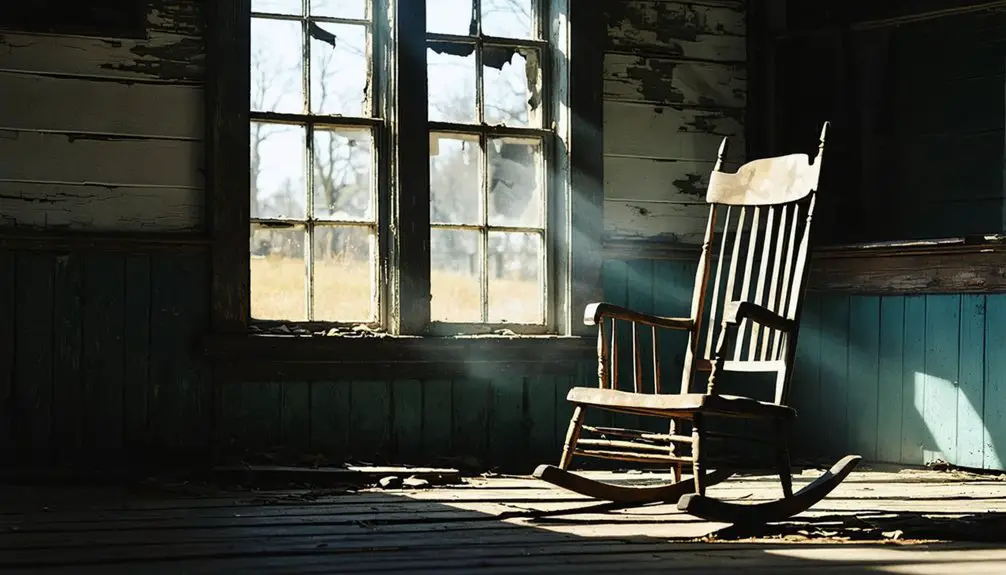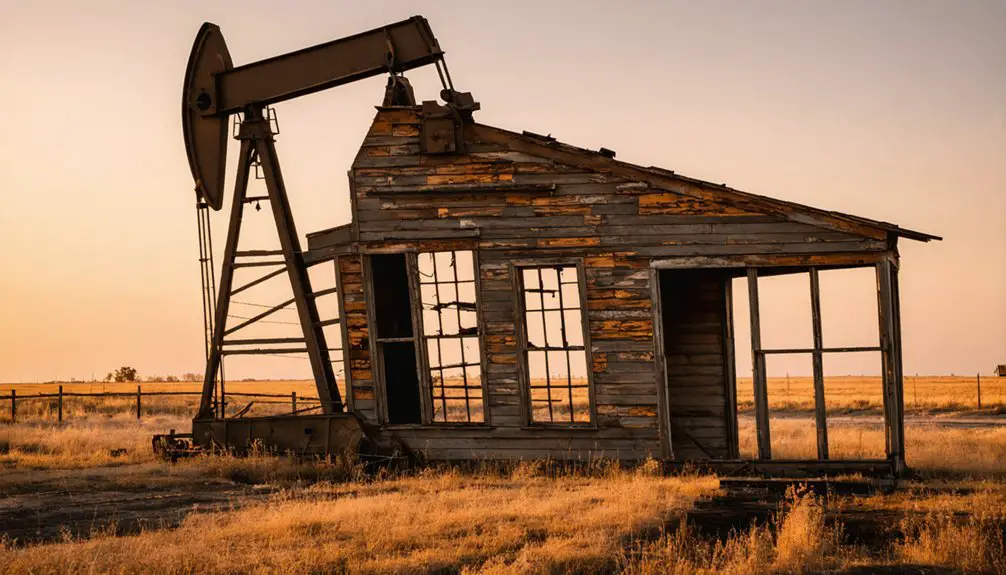You’ll find Oil City, Oklahoma’s remains along the region’s earliest petroleum frontier, where the 1897 Nellie Johnstone No. 1 well sparked a dramatic boom period. This once-bustling town transformed from 200 to 4,000 residents as oil production skyrocketed from 1,000 to 43 million barrels annually. The town’s swift decline came with the 1920s oil bust and Great Depression, leaving behind crumbling foundations, contaminated grounds, and ghostly remnants of its wild industrial heritage. The deeper story of Oil City’s rise and fall reveals fascinating tales of wildcatters, outlaws, and resilient pioneers.
Key Takeaways
- Oil City transformed from a booming oil town of thousands in the early 1900s to a ghost town following the 1920s oil field depletion.
- The discovery of the Nellie Johnstone No. 1 well in 1897 sparked rapid growth, with population surging from 200 to 4,000 residents.
- Social life centered around saloons and gambling halls, creating a rough atmosphere typical of oil boom towns.
- The Great Depression, falling oil prices, and the East Texas oil discovery contributed to Oil City’s ultimate abandonment.
- Environmental damage remains visible through contaminated groundwater, abandoned wells, and crumbling infrastructure overtaken by nature.
The Rise of an Oil Boom Settlement
Three pivotal events sparked Oklahoma’s first major oil boom: the 1897 discovery of the Nellie Johnstone No. 1 well, the arrival of railroads in 1899, and Oklahoma’s statehood in 1907.
This oil discovery initiated a dramatic transformation across the territory, with Bartlesville’s population explosion from 200 to 4,000 residents exemplifying the rapid change.
You’d have witnessed an incredible surge in oil production, from just 1,000 barrels annually to over 43 million barrels within a decade. Native Americans had long used the oil deposits for medicinal purposes before commercial drilling began.
As news spread of the Nellie Johnstone’s success – producing 100,000 barrels and selling at $1.25 per barrel – prospectors, workers, and investors flooded in.
Boomtowns sprouted overnight around major strikes, with property values soaring and makeshift settlements rapidly evolving into bustling centers of commerce. The Red Fork Field discovery in 1901 established Tulsa as the Oil Capital World, transforming the region’s economic landscape.
Life in a Wild West Oil Town
As oil strikes transformed sleepy Oklahoma settlements into bustling boomtowns, daily life took on a distinctly wild and untamed character. You’d find yourself in a rough-and-tumble world where transient lifestyles were the norm, living in hastily built shacks alongside restless young men chasing fortune in the oil fields.
The dangerous, lawless atmosphere shaped every aspect of daily existence:
Life revolved around survival in those lawless days, where danger lurked behind every corner and shaped how people lived.
- Community events centered around saloons and gambling halls, where violence could erupt at any moment.
- You’d brave treacherous roads and paths, dodging trouble while rushing messages or supplies through town.
- Living conditions were stark – overcrowded spaces with minimal sanitation and a constant stream of workers moving in and out. Workers often resorted to bed sharing in shifts just to find a place to sleep.
The lack of law enforcement meant you’d need to watch your back, as disputes were often settled with fists or firearms. Disease outbreaks like tuberculosis and diphtheria spread rapidly through the cramped living quarters.
Economic Peak and Industrial Heritage
You’ll find Oil City’s most prosperous era emerged during Oklahoma’s early oil boom of the late 1890s through the early 1900s, when discoveries at Glenn Pool and Cushing fields transformed the region’s economy.
The city’s rapid industrial development included extensive networks of drilling rigs, refineries, and pipelines, employing thousands in extraction, processing, and transportation roles. The rapid population growth brought waves of workers and their families, transforming the once-quiet town into a bustling industrial center.
This period of intense growth established Oil City as an essential hub in Oklahoma’s transformation from an agrarian economy to an industrial powerhouse, though the prosperity would prove temporary. By 1930, the economic landscape had shifted dramatically as manufacturing sector growth reshaped employment patterns across the state.
Rapid Industrial Growth Era
When Oklahoma City struck oil in 1928 with its Number One well producing 6,000 barrels daily, the discovery launched an unprecedented industrial boom that would reshape the region’s economic landscape.
The city quickly transformed as oil drilling operations spread throughout urban areas, creating a unique industrial zone where derricks stood alongside homes and businesses. The Oklahoma Corporation Commission stepped in to regulate drilling activities, limiting operations to one well per city block. Led by pioneering oilman Thomas B. Slick, numerous wildcatters flocked to the region seeking their fortunes.
You’ll find evidence of this rapid urban expansion through:
- Drilling operations that extended into the state capitol grounds
- Revolutionary directional drilling techniques that maximized production in limited urban spaces
- The establishment of major petroleum companies like Phillips Petroleum and Marland Oil
The industry’s growth helped Oklahoma City largely avoid the Great Depression’s worst effects, providing economic stability and jobs while cementing the region’s position among the top oil producers in the Mid-Continent region.
Oil Wealth’s Brief Legacy
Oil wealth sparked rapid urbanization and infrastructure expansion, with downtown skyscrapers rising as monuments to this transient prosperity.
During the Great Depression, while other regions struggled, Oil City’s petroleum sector provided stable employment for thousands.
Governor Murray’s martial law on drilling helped protect oil values, while the Oklahoma Corporation Commission regulated extraction practices.
Despite the economic stability oil brought, the boomtown environment strained local infrastructure and created regulatory challenges that would foreshadow the city’s eventual decline.
Social Fabric and Community Dynamics
Oil City’s bustling community life in the 1920s reflected the typical chaos of Oklahoma’s boom towns, where you’d find a mainly male workforce living alongside transient families seeking their fortunes in the oil fields.
You’d notice the stark social divisions forming between oil company employees and other residents, while gambling halls and saloons emerged as central gathering spots despite creating tension with more conservative community members.
The town’s rapid population growth brought both economic opportunity and social disorder, as the limited law enforcement struggled to maintain order among the mix of fortune seekers, laborers, and those drawn to illicit activities. Like many towns that experienced quick establishment and decline, Oil City’s population dramatically shifted as oil production waned in the region. Similar to other Oklahoma communities, the town’s establishments often served as illegal liquor outlets to residents from neighboring dry territories.
Boom Era Community Life
Life in early 20th-century Oklahoma boomtowns like Oil City revolved around a vibrant but volatile social fabric shaped by the rhythms of oilfield work.
You’d find community gatherings centered around the town’s saloons and dance halls, where workers sought entertainment after grueling shifts in the oil fields. These social rituals helped forge bonds in a population dominated by transient workers and contractors.
The town’s social structure was defined by:
- Single male workers who frequented the whiskey establishments and gambling halls
- Company-employed families who later brought stability to the community
- Local merchants and service providers who created economic bridges between various social groups
Despite the rough-and-tumble atmosphere, you’d witness how these social connections helped sustain the community through boom-and-bust cycles that characterized Oklahoma’s early oil era.
Population Shifts and Tensions
As the oil fields began to dry up in the 1920s and 1930s, you’d witness dramatic population shifts that transformed Oil City’s social fabric.
The once-bustling community experienced severe population volatility as workers and their families fled in search of new opportunities. You’d see longtime residents pack up their homes while businesses shuttered their doors, leaving behind empty storefronts and abandoned houses.
The exodus created rifts among those who remained, as competition for dwindling resources and jobs intensified.
Younger generations moved to urban areas for education and work, leaving an aging population facing increasing social isolation. The tight-knit community bonds that had characterized Oil City’s boom years unraveled as social gathering spots closed and support networks weakened, fundamentally altering the town’s character and communal identity.
The Great Depression’s Impact

When the stock market crashed in 1929, Oil City’s fate would be sealed by a devastating combination of economic forces. The discovery of East Texas oil fields triggered a price collapse that devastated the local petroleum industry, while the Dust Bowl’s arrival crushed what remained of the agricultural economy.
You’d have witnessed unprecedented economic hardship as unemployment soared above 25% and businesses shuttered across town.
Despite community resilience shown through local relief efforts, three major factors accelerated Oil City’s decline:
- Mass layoffs in both oil and farming sectors
- Plummeting petroleum prices that bankrupted small producers
- Severe drought conditions that forced families to migrate west
Soup kitchens and makeshift camps sprang up as residents struggled to survive, while Governor Murray’s martial law declaration attempted to stem the tide of foreclosures devastating the region.
Crime and Law Enforcement Challenges
If you’d visited Oil City during its tumultuous peak, you’d have witnessed frequent shootouts between lawmen and outlaws as they battled for control of the streets.
The town’s murder rate soared during Prohibition, with bootleggers operating numerous hidden stills and speakeasies that attracted violent criminal elements.
Local newspapers documented daily killings and robberies as law enforcement struggled to maintain order, often finding themselves outgunned and outnumbered by well-organized gangs.
Lawmen Vs Outlaws Conflicts
The discovery of oil in Oklahoma’s boomtowns during the early 1920s sparked a deadly cat-and-mouse game between lawmen and outlaws, particularly in Oil City and Cromwell.
You’ll find that lawman tactics often involved forming posses and coordinating with federal agents, while outlaw strategies included exploiting jurisdictional gaps and corrupting local officials.
Three notable conflicts shaped this violent era:
- The 1923 death of bank robber Al Spencer in a fierce gunfight with U.S. Marshals
- The 1924 murder of legendary lawman Bill Tilghman by corrupt prohibition agent Wiley Lynn
- The 1933 fatal shootout between FBI agents and “The Tri-State Terror” Wilbur Underhill
These deadly encounters transformed Oklahoma’s oil boom towns into battlegrounds where law enforcement fought to maintain order against armed criminals targeting the region’s newfound wealth.
Bootlegging During Prohibition Era
Amid the chaos of lawmen battling outlaws, bootlegging emerged as Oil City‘s most pervasive criminal enterprise during Oklahoma’s unique prohibition era.
You’d find bootlegger networks thriving especially around the oil fields, where demand for illegal alcohol ran high despite Oklahoma being the first state to ban liquor in 1907.
The illicit trade flourished through clever exploitation of legal loopholes, with bootleggers claiming their shipments were for “personal use” while secretly distributing to speakeasies and private clubs.
Local law enforcement, hampered by minimal funding and widespread corruption, often protected these operations for bribes.
In Oil City’s booming economy, bootlegging created a shadow market that undermined legitimate commerce while enriching those who dared to defy the state’s moral crusade against alcohol.
Murder Rate Spikes Daily
Violence gripped Oil City during its decline, with murder rates soaring far beyond Oklahoma’s already-high state average of 6.1 per 100,000 residents.
Like many ghost towns, Oil City’s isolation and economic collapse created perfect conditions for unsolved murder mysteries and unchecked violent crime.
You’ll find the town’s dark history reflected in these grim statistics:
- Murder rates exceeded even Tulsa’s dangerous 8.92 per 1,000 residents
- Drug-related homicides spiked as meth and crack addiction spread
- Limited law enforcement resources left most violent crimes unsolved
Local crime prevention efforts collapsed as the population dwindled, leaving remaining residents vulnerable.
Without adequate police presence, the town’s abandoned buildings became havens for criminal activity, mirroring the struggles of other declining Oklahoma oil towns where poverty and addiction fueled deadly violence.
Architectural Remnants and Lost Infrastructure
Crumbling foundations and weathered wooden frames tell the story of Oil City’s architectural decline, where once-bustling neighborhoods have largely surrendered to nature’s reclamation.
Time and neglect have transformed Oil City’s vibrant streets into silent ruins, as nature slowly reclaims what industry once built.
You’ll find sporadic remnants of early 20th-century worker housing, their structural decay evident in sagging rooflines and deteriorating walls. The architectural significance of these simple wooden dwellings reflects the working-class origins of this former boomtown.
Abandoned mine shafts, now flooded, dot the landscape alongside collapsed processing facilities and loading docks.
The ground itself bears witness to the area’s mining legacy, with 8-10 foot subsidence zones marking where major shafts once operated.
Railroad infrastructure has vanished, though you might spot occasional track remnants or overgrown corridors where the Rock Island and Katy lines once transported coal and connected communities.
Notable Characters and Local Legends

Through the lawless streets of Oil City’s heyday strode some of Oklahoma’s most colorful figures, from Ernest W. Marland’s rise to governor to notorious outlaws who terrorized the region.
You’ll find that Oil City’s legacy lives on through local legends of:
- Whiskey town operators who ran dangerous saloons where shootouts and strife were commonplace
- Oil executives whose influence shaped entire communities, lending their names to towns like Wolco and Carter Nine
- Roughnecks and messengers who braved violent streets, dodging trouble in infamous spots like Whizbang
The area’s ghostly encounters still echo through abandoned buildings, where tales of quick fortunes and sudden ruin mingle with supernatural folklore.
These stories paint a vivid picture of boom-era Oklahoma, when outlaws and entrepreneurs carved out their destinies in equal measure.
Environmental Legacy and Natural Reclamation
While the oil boom brought fleeting prosperity to Oil City, its environmental aftermath has left an indelible mark on the landscape.
You’ll find legacy pollution from abandoned wells releasing methane and toxic liquids into the soil and groundwater. These sites continue to emit volatile organic compounds that have forced locals to evacuate their homes due to health risks.
Nature’s slow reclamation process is evident as vegetation gradually returns to the contaminated areas, though plant growth remains stunted by toxic conditions.
The concrete foundations of former oil structures are slowly disappearing beneath new soil and plant life.
However, the environmental challenges persist – induced earthquakes from historic wastewater injection threaten structural stability, while contaminated groundwater continues to affect the region’s water quality, leaving a complex environmental burden for future generations.
Historical Preservation Efforts Today

Despite Oil City’s widespread deterioration, coordinated preservation efforts have emerged through partnerships between the Oklahoma Historical Society and local advocacy groups.
You’ll find preservation challenges being tackled through a mix of federal funding and grassroots initiatives, with the SHPO leading documentation efforts despite uncertain budget conditions.
Key preservation activities include:
- Community engagement through Preservation Oklahoma’s “Most Endangered Places” listing program
- Local historical societies organizing volunteer-driven restoration projects
- Professional documentation of remaining structures by historians and archaeologists
You can participate in these efforts through public nominations of endangered sites or by joining local preservation groups.
While federal funding covers 60% of preservation costs through the Historic Preservation Fund, community involvement remains essential for maintaining Oil City’s historical integrity and preventing further deterioration.
Frequently Asked Questions
Are There Any Accessible Underground Oil Tunnels Remaining Beneath Oil City?
Ever wonder what lies beneath the surface? You won’t find any accessible oil tunnels there today – despite the region’s rich subterranean history, there’s no documented evidence of explorable oil tunnel networks beneath Oil City.
What Happened to the Wealth Accumulated by Successful Oil City Residents?
Your early oil boom wealth vanished during economic decline – you’d have seen fortunes lost through oil field depletion, property value crashes, and the Great Depression’s devastating impact on regional commerce.
Did Any Major Hollywood Films Ever Feature Oil City’s Story?
You won’t find any Hollywood adaptations of Oil City’s story – it’s never been featured in major films. The film industry influences focused on fictionalized oil boom towns rather than this specific location.
What Native American Tribes Originally Inhabited the Land Where Oil City Stood?
You’ll find the Osage Nation dominated this native land, while Plains tribes like Comanche, Kiowa, Cheyenne, and Arapaho hunted there. Earlier tribal history includes the ancient Spiro Mound builders’ presence.
Were There Any Documented Paranormal Occurrences in Abandoned Oil City Buildings?
Like shadows dancing in empty halls, you won’t find solid evidence of paranormal investigations or ghost sightings in Oil City’s remains. Local folklore hints at unexplained phenomena, but documented cases don’t exist.
References
- https://nondoc.com/2022/01/04/whizbang-oklahoma-ghost-town/
- https://okmag.com/blog/a-ghostly-site/
- https://en.wikipedia.org/wiki/List_of_ghost_towns_in_Oklahoma
- https://www.youtube.com/watch?v=5d-wHDTIbb0
- https://www.okhistory.org/publications/enc/entry?entry=GH002
- https://www.metrolibrary.org/archives/essay/2019/07/black-gold-oil-gushes-oklahoma-city
- https://www.okhistory.org/publications/enc/entry?entry=PE023
- https://www.youtube.com/watch?v=AYcQus6lA-U
- https://aoghs.org/petroleum-pioneers/first-oklahoma-oil-well/
- http://www.ogs.ou.edu/fossilfuels/pdf/OKOilNotesPDF.pdf



